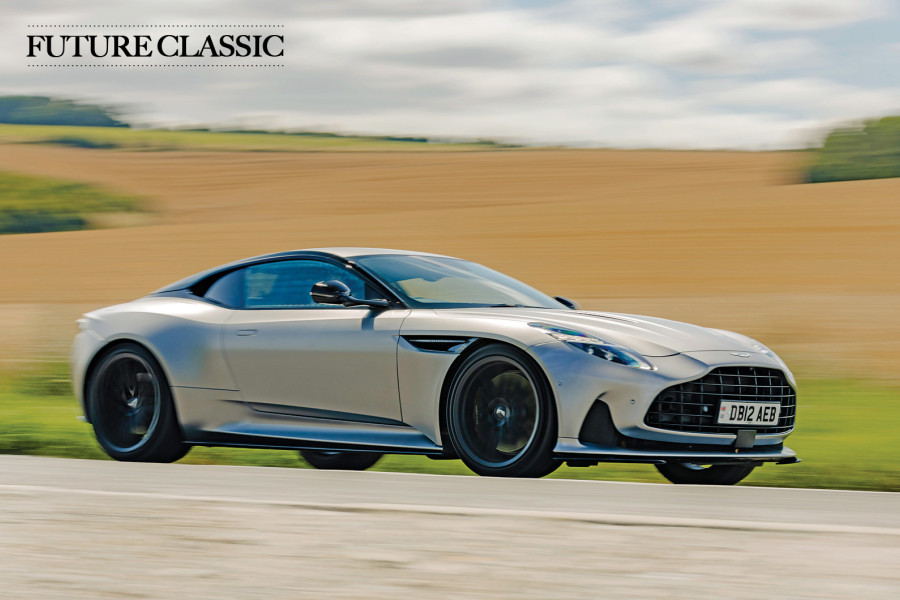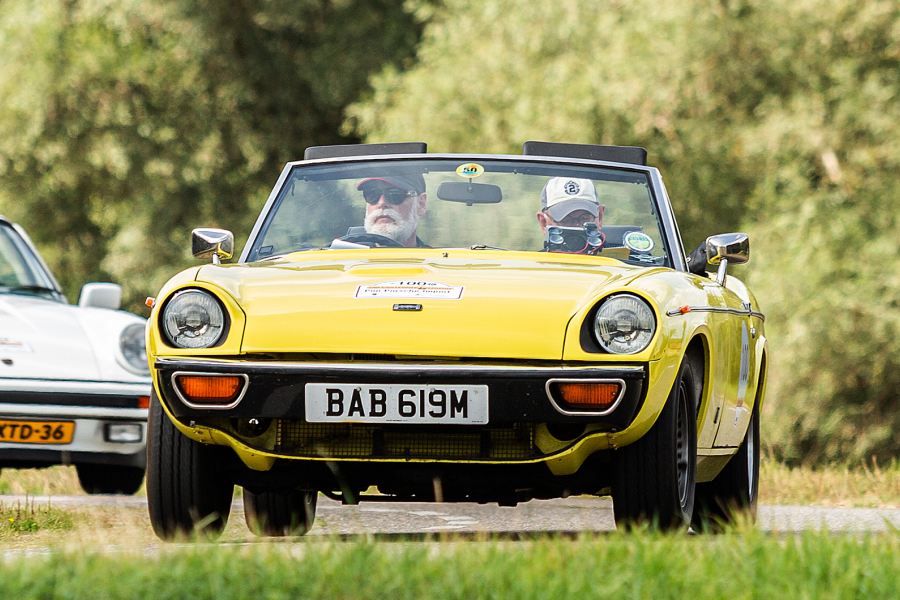Hydraulic tappets muffle the Jensen’s V8 from the inside, but there is a lovely, soft motor-launch burble from the exhaust that sounds urgent but not aggressive.
The Aston Martin V8 edges the Jensen Interceptor III for rear-seat space
The complex metallic fizz of four camshafts and two-stage duplex chains gives the bellowing Aston a whole other visceral dimension that sympathetic ears connect with instantly.
In terms of acceleration, the Jensen Interceptor is more instantly impressive thanks to stronger torque at lower revs and more bite to its torque converter.
While the Aston V8 slurs – there is a sense that the engine is revving uselessly against a slipping clutch up to about 40mph – the Interceptor has wafted away.
Beyond that sort of speed – as long as you don’t snap its beautifully weighted throttle open and drown the Webers – the Aston takes command, with the sort of thrilling pick-up that focuses the mind yet without ever exceeding 4000rpm or holding the gears manually.
The Aston Martin V8’s huge bonnet vent helps with engine cooling
Subjectively, the Aston seems the quicker, more exciting car on the road and contemporary road-test figures tell much the same story.
But there is not that much in it, plus the Jensen delivers the goods more effortlessly with less fuss and bluster.
With your foot to the floor, its Torqueflite flicks smoothly into top from intermediate at 90mph, whereas the Aston is designed to change up at well over a ton if necessary.
In top, both of these 4000lb GTs are geared to cruise at 100mph showing about 4000rpm.
The Aston Martin’s hand-built, quad-cam, V8 motor
The Jensen is a car that I’ve always had a huge affection for and always will.
Chrysler power was a selling point central to the Interceptor’s identity rather than a guilty secret.
It gave the car a wide appeal (they sold at a rate of 30 a week at the height of its success) to the kind of customer who liked the idea of a big, understressed engine, but was not necessarily interested in the finer details of what went on under the bonnet.
The disinterest shown by Jensen buyers in the wonderful FF showed that few were willing to pay £2000 extra for the benefits of four-wheel drive and anti-lock brakes.
The Aston Martin V8 corners flatter, with sharper steering
I mention the FF because it is one of my all-time favourites that gave the Interceptor concept an added dimension of high-tech credibility, making a very good car truly great.
Had we been comparing an FF with an Aston – any Aston – there would, for me, be no contest.
In some respects, the Aston V8 is more difficult to warm to and my feelings about the model have been tainted by the travesties wrought upon them by factory bodykits that undermined the elegance of a classic shape.
Unload that baggage and I have to admit that the Aston shows flashes of brilliance and depth of personality that the Jensen can’t quite match.
Images: Tony Baker
Thanks to: Nikos Gianniris and Byron International for the Aston; Peter Harwood and Cotswold Classic Car Restorations for the Jensen
This was first in our September 2014 magazine; all information was correct at the date of original publication
Factfile
Aston Martin V8
- Sold/number built 1972-’90/c2000
- Construction steel platform chassis, with alloy body
- Engine all-alloy, qohc 5340cc 90º V8, with four twin-choke Weber 42 DCNF carbs
- Max power c320bhp @ 5000rpm
- Max torque c400Ib ft @ 4000rpm
- Transmission ZF five-speed manual or Chrysler Torqueflite three-speed auto, RWD
- Suspension: front double wishbones, coil springs, telescopic dampers, anti-roll bar rear de Dion axle, parallel links, Watt linkage, coil springs, lever-arm dampers
- Steering Adwest power-assisted rack and pinion, 2.9 turns lock-to-lock
- Brakes vented discs all round, 10¾in front, 10½in rear, with twin servos
- Length 15ft 1¼in (4603mm)
- Width 6ft (1823mm)
- Height 4ft 4in (1321mm)
- Wheelbase 8ft 6¾in (2610mm)
- Weight 3930lb (1782kg)
- Mpg 9-16
- 0-60mph 6.2 secs
- Top speed 146mph
- Price new £9057 (’73)
Jensen Interceptor III
- Sold/number built 1971-’76/3419 (6175 including I and II, plus 232 SPs and 320 FFs)
- Construction tubular steel chassis, with steel body
- Engine all-iron, ohv 7212cc 90º V8, with Carter quad-choke carb
- Max power 284bhp @ 4800rpm
- Max torque 383Ib ft @ 3200rpm
- Transmission Chrysler Torqueflite three-speed auto, driving rear wheels
- Suspension: front double wishbones, coils, anti-roll bar rear Salisbury live axle, semi-elliptics, Panhard rod; telescopics f/r
- Steering Adwest power-assisted rack and pinion, 3.4 turns lock-to-lock
- Brakes vented discs all round, 10¾in front and rear, with servo
- Length 15ft 8in (4775mm)
- Width 5ft 10in (1778mm)
- Height 4ft 5¼in (1353mm)
- Wheelbase 8ft 9in (2667mm)
- Weight 3931lb (1783kg)
- Mpg 10-14
- 0-60mph 6.4 secs
- Max speed 140mph
- Price new £6981 (’73)
Enjoy more of the world’s best classic car content every month when you subscribe to C&SC – get our latest deals here
READ MORE
Buyer’s guide: Aston Martin V8/Vantage
Buyer’s guide: Jensen Interceptor and FF
Driving the cars of The Saint: Volvo P1800, Jaguar XJ-S, Jensen Interceptor and Volvo C70
Martin Buckley
Senior Contributor, Classic & Sports Car
























